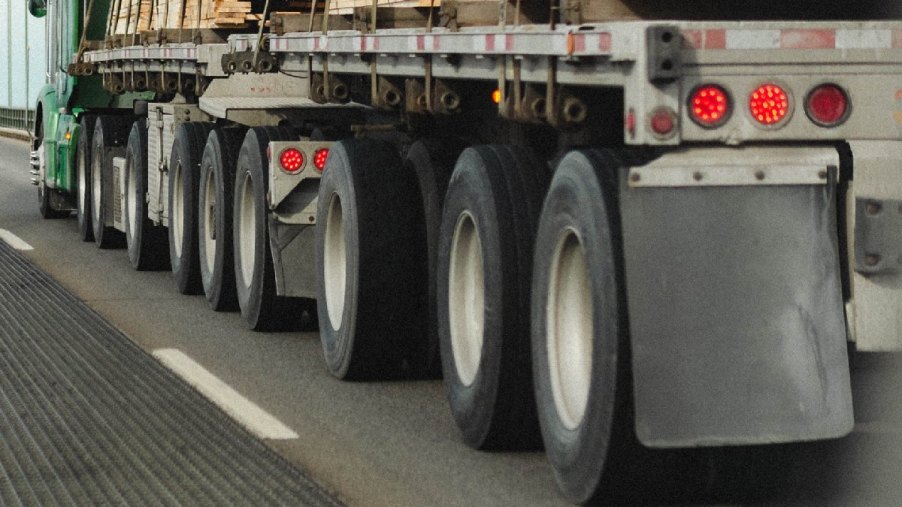
Why Do Semi-Trucks Have so Many Wheels? 18, 24, or More!
Most of you have likely experienced a massive semi-truck rolling by a highway. These vehicles play an essential role in transporting goods around the country, whether hauling food, cars, electronics, or fuel. One of the peculiar aspects of these long-haul trucks is they have so many wheels and tires. Also, some call them “18-wheelers” due to this being the standard for big rigs. Let’s explore the reasons why semi-trucks have so many wheels and tires.
Reasons why semi-trucks have 18 or more wheels and tires

While most semi-trucks have 18 wheels and tires, this isn’t always the case. Some have 10, while others have more — 24 or 36. Per Motor Hills, for a standard 18-wheeler, the setup is as follows — moving from the front to the rear:
- Front axle, under the hood: two
- Under the front of the trailer: four
- Right behind those, under the trailer: four
- Further back on the trailer: four
- Rear section of the trailer: four
For 10-wheelers, the wheels aren’t doubled up. There are only two for each axle. Also, for 24 and 36, the wheels are closer together, or there’s a longer trailer. Additionally, some trucks haul more than one trailer, like a train pulling multiple boxcars.
Support heavy loads in the trailer
One of the biggest reasons why semi-trucks have so many wheels and tires is to support heavy loads in the trailer. The force of this weight puts a considerable amount of pressure on the tires. If there were a smaller number of tires, they would pop under the stress of a heavy load. By having 18 or more, the weight is distributed — with less pressure on each one.
Also, when turning or suddenly braking, the product in the trailer can move, causing the weight to shift to one side. With the support of more wheels and tires, a truck can handle the force of this shifting weight.
Prevents accidents if a tire blows out

With the heavy loads and the considerable number of miles that semi-trucks travel, tire blowouts are common. Doubling them up with four per axle prevents a dangerous accident after a blowout. A trucker can continue driving and move to the side of the road to fix the blown tire.
US Department of Transportation loading standards
The United States Department of Transportation has loading standards with weight limits for semi-trucks. This includes:
- Steering axle: 12,000 pounds
- Individual axles: 20,000 pounds
- Tandem axles: 34,000 pounds.
Also, semi-trucks must stop at weigh stations along the highway to ensure they legally meet these loading requirements. If a truck has fewer axles, tires, and wheels, it legally can’t carry as much weight. By having more, it can haul a heavier load, which is more cost-effective.
18 or more wheels and tires provide stability for semi-trucks
Another reason is stability. More tires touching the ground results in a more stable ride. If there was a smaller number, a truck could flip or spin out, particularly when making a turn. Think of a bicycle or a tricycle. It doesn’t take much for either of these to crash to the ground during abrupt maneuvering. However, with more tires on the ground, a truck is more stable and balanced.
Off-road driving and travel on roads in poor condition
While semi-trucks mostly travel on smooth highways and streets, sometimes they have to go on roads in poor condition, such as ones with potholes, loose gravel, and cracks. Also, to make deliveries, trucks occasionally drive off-road, especially in remote areas of the country. More wheels and tires mean better performance and higher safety for driving on rough and uneven surfaces.
Drop axles: Tires that don’t touch the ground
Some semi-trucks have tires that don’t touch the ground. These “floating” tires are called drop axles. While there are many benefits of having 18 or more wheels and tires, the trade-off is a truck is less maneuverable. This makes it more difficult to make tight turns and drive through traffic and parking lots. It lowers gas mileage, too.
However, the drop axles address these problems. With two axles in the stored position and four tires not touching the ground, a semi-truck is more maneuverable. So, instead of 18 tires for a standard 18-wheeler, it temporarily switches to 14 touching the ground. And when the load is heavy, the driver can lower the axles to have all 18 touch the ground.
There are many reasons why semi-trucks have 18 or more wheels and tires. This includes supporting heavy loads, withstanding shifting weight, preventing accidents during a blowout, meeting government loading standards, providing stability, and delivering better performance for off-road use and travel on roads in poor condition.
Also, if you see a drop axle truck with the tires off the ground, it means the driver wants to maximize maneuverability.





